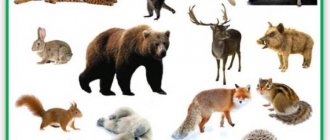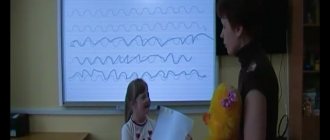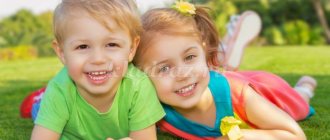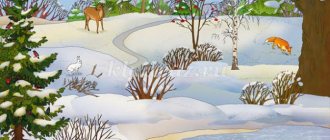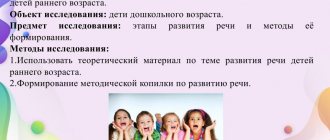Summary of a lesson on speech development for children of the senior group. Pets and their babies
Summary of a lesson on speech development for children 4-6 years old.
Topic: “Domestic Animals” Purpose: Enriching the vocabulary on the topic “Wild and Domestic Animals”, developing children’s coherent speech. Objectives: Educational:
Continue to develop in children the ability to form and use possessive adjectives and nouns in the prepositional case in speech.
Developmental:
Develop coherent speech.
Arouse interest in the life of animals, develop skills in environmentally friendly behavior; expand vocabulary, develop imagination, curiosity, memory and thinking of children. Educators:
Foster a caring attitude towards animals.
Preliminary work: 1. Examination of illustrations, albums on the topic: “Animals”, compiling stories from the pictures. 2. Carrying out didactic games “Who lives where?”, “The fourth odd one”, “Friendly families”, “Make a picture” 3. Carrying out outdoor games “Wolf and Hares”, “Fox in the Hen House”, “Sly Fox”, 4. Game situations based on the rules for treating animals. 5. Conversation with children about whether they have pets, where they live, how to care for them, what to feed them. 6. Looking at pictures from the series “Pets and their babies.” Reading poems and nursery rhymes about pets, memorizing some of them. 7. Laying out silhouettes of pets from scrap materials Equipment: subject pictures depicting pets;
card with an image of an animal (rabbit); pictures of animals without tails, pictures of tails; card, complete the animal; colored pencils, a magnetic board, supporting diagrams for storytelling, a box with an egg, a ball of thread, mittens, a hat, a scarf, knitted socks; goose or chicken feathers, packages of milk, butter, cottage cheese, sour cream, cheese; drawings for the game “Whose Tail”. Hod OOD:
Educator:
Guys, do you like animals?
Please tell us who has what animals? (Children's stories) Educator:
Now I will ask you riddles, and you must guess them.
But the riddles are not simple... “Riddles of the decoy” Singing sleepily On the roost... is a piglet? They mooed early in the morning. We have... sheep in our yard? “I-go-go” I’m used to shouting and pounding my hoof... a bull? A shaggy... cat barks loudly at people? Yesterday I brought a mouse home, Our fluffy red... dog? Digging the ground near the porch with his Piglet... a sheep? My granddaughter and grandmother were tending me in the meadow. I saved milk, And I’m called... a butterfly (cow) Educator:
Game “Who gives what voice?”
Rules of the game:
One participant is the driver.
He turns his back to the children. At the teacher’s command, one of the children calls the driver as a pig or a chicken, a cow, etc. might call him. The driver guesses the name of the child who called him and says what kind of pet or bird he was speaking in at that moment. Then another child becomes the driver. Didactic game
“Whose tail?”
There are pictures of animals on the table, but without a tail. We need to find the tail of each animal. Children answer the question “Whose tail?” and place the correct picture next to the animal. Physical education lesson “Rabbits” We visited a farm (children walk in a circle, holding hands) We saw white rabbits. Nimble rabbits (run in a circle, making “ears” out of their fingers) They lay down, (lie down) Then they circled (circled) in a wire house. They clapped their paws (clap their hands) and squealed merrily. (they stomp their feet) We are the animals (they walk in a circle, holding hands) Not tough grass - We’ll get it for Clover... Grow up (they jump in a circle, making “ears” out of their fingers) With delicate fur, With round tails.
Pet Gifts
Moment The “box” is brought out to the music. It contains: an egg, a ball of thread, mittens, a hat, a scarf, knitted socks; goose or chicken feathers, packages of milk, butter, cottage cheese, sour cream, cheese, etc. Educator:
Guys, every animal benefits a person, in this box there are objects that the animal gives to people.
Children take turns taking an object out of the box and guessing which of the pets could give it to people. Articulation exercises: “Calf” - chewing movements, while the mouth is closed.
“Angry Fluff” - the mouth is slightly open,
the tongue is in the form of a “bridge”.
“Hooves” -
click your tongue while keeping your mouth open.
The tongue, after all, is like hooves,...... It can work loudly.
Clack, clack, clack, - and he won’t get tired,...... He will only clack harder. “Fluff laps milk” - lactation movements with the tongue.
The cat loves milk and drinks it from a saucer.
How? Willingly and easily. Not tired at all! “The horse is smiling” - the lips are stretched in a smile, the teeth are clenched and clearly visible. “The dog is hot!” It’s hot for our Friend: (Stick your tongue out of your mouth, breathe in and out frequently.) He ran around the meadow! The tongue fell to the side, (accordingly) The friend was tired - he drank some water. (Lactatory movements with the tongue.) Educator
: Now each of you will draw your own “Non-existent animal.”
For example, the head is from a dog, the body is from a horse, the legs are from a goose, etc. Tell us about your animal: what it eats, where it lives, what it does. Educator
: Guys, what did you like in class today? What and who were we talking about? What new and interesting things did you remember and learn?
We recommend watching:
Lesson on speech development and familiarization with the environment in the senior group. Summary of a lesson on speech development for children in the senior group. Topic: “How winter meets spring” Summary of a lesson on speech development for older preschoolers Summary of a lesson on speech development in the senior group for children with a stutter: Winter fun
Similar articles:
Summary of a lesson on speech development in the senior group. Retelling of a work of art. Ushinsky “Medicine”
Summary of a lesson on speech development in the senior group. Funny riddles
Lesson notes on speech development in the senior group
Lesson summary on the topic “Relationships in the family.” Senior group
Lesson on emotional development in the senior group
Summary of a lesson on speech development in the middle group. Wild animals
Abstract of the educational activity on speech development “Journey to the forest to see wild animals” for children of the middle group (age from 4-5 years)
Author: Oksana Viktorovna Borodina, teacher of the highest qualification category MBDOU “Combined kindergarten No. 21”, Amursk, Khabarovsk the edges. Description of the material: I offer you a summary of direct educational activities for children of the middle group (age 4 to 5 years) on the topic “Journey to the forest to see wild animals.” This material will be useful to teachers of the middle group on the use of symbols - prepositions and on working with the picture-graphic plan of a chain organization. Objectives: 1. Teach children to use prepositions with spatial meaning in speech, relying on prepositional symbols. Improving the grammatical structure of speech (composing a simple sentence with visual support). Continue to teach children to accurately, consistently, coherently and grammatically correctly retell a short story based on the pictorial and graphic plan of the chain organization, to build complete sentences. Practice agreeing verbs with nouns in gender, number and case using a mnemonic table. Reinforce the pronunciation of the sound [s] in words and phrases. Promote the formation of correct posture, prevent flat feet, and improve “snake” running between objects. 2. Develop skills in the use of the simplest forms of symbolization, symbolic designation of objects when performing tasks; develop the ability to properly regulate the tempo and strength of your voice; coordination of speech with movement, motor activity, coherent speech. 3. Formation of interest in wildlife, goodwill, and cooperation skills. Equipment: cards of symbols-prepositions, mnemonic table, pictures of wild animals, pictures (drifts, branches, hollows, dens, winter trees), presentation, laptop, projector, graphic plan for retelling, bricks, skittles, ribbed path, arc, “Bunny dance "(music by Zheleznova), chest, cabbage, fish, barrel of honey, envelope with letter, magnetic board, magnets. Preliminary work: looking at pictures of wild animals, reading fairy tales, stories about wild animals in winter, learning the physical exercise “Bunny Dance” (music by Zheleznova); acquaintance with preposition symbols, mnemonic table. Integration of educational areas: physical development, artistic and aesthetic development (music), cognitive development (E)
Progress of the GCD
Organizational moment: Like there is snow on a hill, snow And under the hill there is snow, snow And a bear sleeps under the snow Quiet, quiet, don’t make noise. Letter Teacher: “Hello, guys! Old man Lesovichok gave us his chest, but we just can’t open it. Come quickly and help out the forest animals.” Educator: Sonya, where do wild animals live? (in the forest) Educator: Well, should we go into the forest and help out the animals? So we got ready for the journey, set off into the winter forest. The path is interesting, everything is good for health. (walking)
We walk through the snowdrifts, raising our legs.
(walking with a high hip lift)
And on the ice we walk quietly and easily
(walking on toes)
.
“It’s not so easy to get through here, the tunnel lies here on the way” (Climbing under the arch)
“And here is the bridge and everyone can walk along the bridge beautifully, I walk along the bridge, holding my arms to the sides.”
(Walking on a ribbed board)
“We will put our feet together and begin to jump like hares.”
(Jumping over bricks)
So as not to fall through the trees and bushes in the snow, we will rush merrily.
(running like a snake)
“Our legs are not tired, we will stretch a little.”
(Breathing exercise) Educator: So we came to the forest, but for some reason there was no one, the animals were probably scared of us and hid, and where now we find out Game with prepositions “Bridge” (the bridge will be a preposition diagram, you need to connect the words in the pictures with the help of a bridge - a preposition, so that a sentence is formed, and we find out where someone is hiding)
preposition symbols:,: under, behind, over, on, about, between
Children make up sentences one by one: “The fox is hiding behind the spruce tree.”
"The squirrel is hiding in a tree." "The hare is hiding under a bush." "The bear is hiding in a den." "The wolf is hiding between the snowdrifts." Educator: So we found all the animals. Come out and don't be afraid of us! (animals come out: bear, fox, bunny) Educator: Let's praise the little fox: Speech gymnastics. Su-su-su - I saw a fox in the forest. Sy-sy-sy - the fox has a beautiful tail, Sa-sa-sa - that's a beautiful fox. We pronounce the clear phrase with different voice strengths (quietly-louder-louder, quickly and slowly).
Where is your chest?
The animals show the chest Educator: Guys, I know the magic words, repeat after me: Chick, chuk, chuck, chock - open, chest! Let's do it together! (the teacher looks into the chest)
.
Educator: Guys, how many gifts Lesovichok has prepared for the animals here. Educator: Let's make friends with animals ICT Working with a mnemonic table Agreement in gender, number and case
Educator: Let's dance with the little bunny Dynamic pause “Dance the little bunny” (music by Zheleznova) Compiling a story for a chain organization according to a picture and graphic plan: Educator: Listen, guys, what happened one day to the little bear. The teacher reads the story: “THE BEAR CUB AND THE COCK” 1. One day a hunter found a bear cub in the forest. 2. He brought the bear cub to the village. 3. In the village, the hostess began to look after him. 4. She had a bully rooster. 5. One day he fluffed his wings and chased the animal. 6. Out of fear, the bear cub hid in the doghouse. Questions 1. Who did the hunter find in the forest? 2. Where did he bring the bear cub? 3. Who in the village began to look after him? 4. Who lived with the landlady? 5. What did the rooster do? 6. Where did the bear cub hide? (according to the degree of answers to questions, children come out one at a time and display pictures on a graphic panel)
Then, one child composes the entire story, and the others evaluate the resulting story according to the scheme of raising the sun or cloud
(if the story did not work out)
.
After the children’s retelling, the teacher asks a problematic question.
Educator: Oleg, what do you think about the hunter’s action? (children's answers) Educator: absolutely right, the hunter did very well, because in the winter, without his parents, the little bear cub died. It turns out that the hunter, who went hunting to kill animals, saved the life of the bear cub. Educator: How do you think animals fare in winter? Educator: Yes, it’s hard for animals in winter, they don’t have enough food and we have to help them, like the old man Lesovichok did, he made the best gift for the animals, he left them food. Educator: What did we do in class today? (performed different tasks, played...)
- Which tasks turned out to be difficult for you?
— What helped you complete this or that task? (diagram, model) Educator: What did you understand from the story about the bear cub? (you need to help even wild animals and not leave them in trouble)
Presentation on the topic: Wild animals
We recommend watching:
Summary of a lesson on speech development in the middle group on the topic: “Ukraine is my native land” Summary of a lesson on environmental education in the junior group on the topic: “Journey to a wonderful forest” Short-term project in the senior group of a preschool educational institution. Wild animals Summary of educational activities on forest animals for children of the younger group of preschool educational institutions
Similar articles:
Summary of a lesson on speech development in the middle group on the topic “Our Street”
